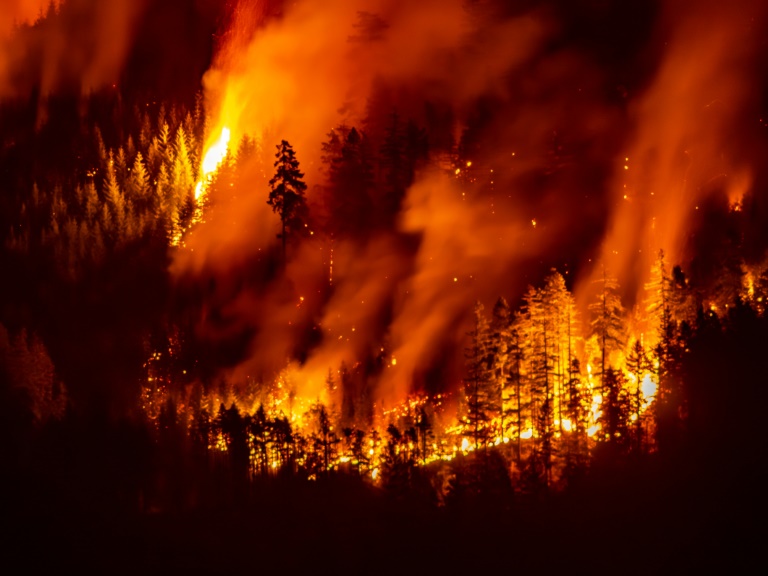World
Record Wildfires Drive Air Pollution Surge Across North America

Global air pollution is on the rise, with North America facing significant increases attributed to unprecedented wildfires fueled by climate change. A recent study from the Air Quality Life Index (AQLI) highlights that the United States and Canada are experiencing sharp surges in particulate matter, reversing decades of progress in air quality.
According to the AQLI annual report, which leverages satellite data to monitor particulate levels globally since 1998, Canada’s wildfire season in 2023 resulted in a staggering increase of over 50 percent in particulate levels compared to the previous year. The United States recorded a 20 percent increase. These findings underscore the concerning trend of worsening air quality driven by climate factors, including rising temperatures and drought linked to human-caused greenhouse gas emissions.
Impact on Human Health and Life Expectancy
Michael Greenstone, an economics professor at the University of Chicago and co-creator of the AQLI, emphasized the profound health risks posed by particulate matter. He stated, “Particulate matter remains the greatest external threat to human health on the planet, period. It’s worse than tobacco smoke. It’s worse than child and maternal malnutrition. It’s worse than road accidents. It’s worse than HIV-AIDS.”
The report reveals that more than half of Canadians were exposed to air pollution exceeding the national standard of 8.8 micrograms per cubic meter. This marks a dramatic increase from less than five percent over the past five years. The hardest-hit regions included the Northwest Territories, British Columbia, and Alberta, where pollution levels were comparable to those in Bolivia and Honduras, leading to a reduction in life expectancy by nearly two years.
The situation is evolving, as the 2025 wildfire season is already being noted as Canada’s second worst. Greenstone remarked on the surprising resurgence of air pollution in parts of North America and Europe, likening it to a “zombie that we thought we had killed, and now it’s back.”
While California has historically been known for its high pollution levels, the impact of Canadian wildfires has shifted the focus to downwind states such as Wisconsin, Illinois, Indiana, and Ohio, as well as regions further south.
Global Trends and Regional Variations
On a broader scale, global fine particulate levels have risen from 23.7 micrograms per cubic meter in 2022 to 24.1 in 2023, significantly exceeding the World Health Organization’s guideline of five. The increase is particularly pronounced in Latin America, which recorded its highest pollution levels since 1998, with Bolivia being the most affected country.
South Asia remains the most polluted region, seeing a 2.8 percent increase in pollution levels, while even China, which had demonstrated consistent improvements in air quality, recorded a slight rebound of 2.8 percent after years of decline under its “War on Pollution.”
Despite these alarming trends, there were some positive developments. Within the European Union, particulate concentrations decreased by six percent, and Central and West Africa saw an eight percent drop in pollution levels.
The AQLI report serves as a stark reminder of the complex relationship between climate change and public health, highlighting an urgent need for effective interventions to mitigate the impact of wildfires and air pollution on human health across the globe.
-

 Science2 months ago
Science2 months agoToyoake City Proposes Daily Two-Hour Smartphone Use Limit
-

 Health2 months ago
Health2 months agoB.C. Review Reveals Urgent Need for Rare-Disease Drug Reforms
-

 Top Stories2 months ago
Top Stories2 months agoPedestrian Fatally Injured in Esquimalt Collision on August 14
-

 Technology2 months ago
Technology2 months agoDark Adventure Game “Bye Sweet Carole” Set for October Release
-

 World2 months ago
World2 months agoJimmy Lai’s Defense Challenges Charges Under National Security Law
-

 Technology2 months ago
Technology2 months agoKonami Revives Iconic Metal Gear Solid Delta Ahead of Release
-

 Technology2 months ago
Technology2 months agoSnapmaker U1 Color 3D Printer Redefines Speed and Sustainability
-

 Technology2 months ago
Technology2 months agoAION Folding Knife: Redefining EDC Design with Premium Materials
-

 Technology2 months ago
Technology2 months agoSolve Today’s Wordle Challenge: Hints and Answer for August 19
-

 Business2 months ago
Business2 months agoGordon Murray Automotive Unveils S1 LM and Le Mans GTR at Monterey
-

 Lifestyle2 months ago
Lifestyle2 months agoVictoria’s Pop-Up Shop Shines Light on B.C.’s Wolf Cull
-

 Technology2 months ago
Technology2 months agoApple Expands Self-Service Repair Program to Canada









